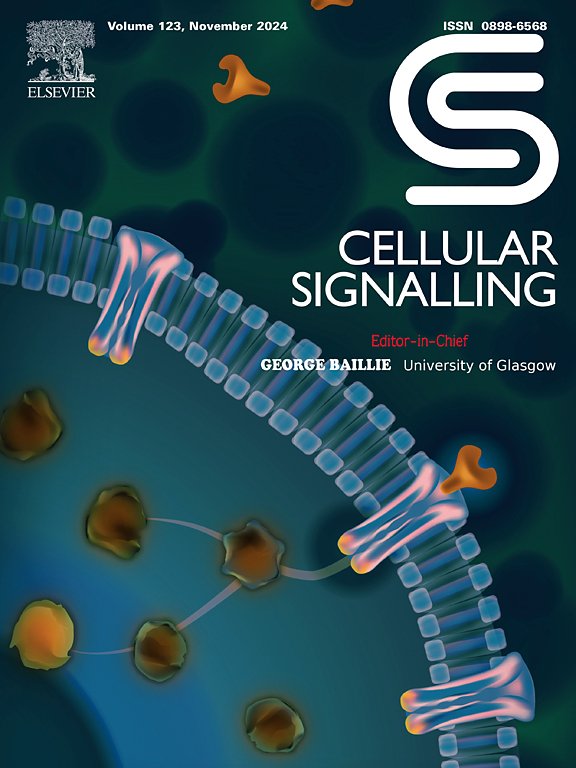转录因子ZNF207驱动有氧糖酵解并促进肝细胞癌的恶性进展。
IF 3.7
2区 生物学
Q2 CELL BIOLOGY
引用次数: 0
摘要
锌指蛋白207 (ZNF207)是锌指蛋白家族的重要成员,在包括肝细胞癌(HCC)在内的各种癌症类型中均表现出一致的上调。不幸的是,ZNF207在HCC中的具体致癌机制尚不清楚。我们的研究采用生物信息学分析、细胞功能实验、双荧光素酶报告基因检测、ChIP和qPCR研究以及裸鼠皮下肿瘤移植和尾静脉肺转移模型的体内研究等综合方法,深入探讨其致癌特性的分子机制。本研究发现ZNF207在HCC组织中过表达,与总生存率降低相关,其表达水平在HCC中的独立预后意义。此外,ZNF207的过表达被证明可以增强HCC细胞的活力、增殖和侵袭能力。机制分析指出,ZNF207调节ENO1和GAPDH转录,促进有氧糖酵解和恶性进展。随后的体内实验证实,沉默ZNF207可以抑制裸鼠皮下肿瘤和肺转移结节的生长,从而延长其生存期。更重要的是,Pinosylvin通过特异性靶向ZNF207发挥其抗肿瘤作用,在体外下调GAPDH和ENO1表达,抑制有氧糖酵解,抑制HCC进展。总之,这些观察结果强调ZNF207是HCC的关键癌基因,具有治疗这种恶性肿瘤患者的潜力。本文章由计算机程序翻译,如有差异,请以英文原文为准。
Transcription factor ZNF207 drives aerobic glycolysis and facilitates malignancy progression in hepatocellular carcinoma
Zinc-finger protein 207 (ZNF207), a prominent member of the zinc finger protein family, exhibits consistent upregulation in various cancer types, including hepatocellular carcinoma (HCC). Unfortunately, the specific oncogenic mechanism of ZNF207 in HCC remains unknown. Our research involved a comprehensive approach, utilizing bioinformatics analysis alongside cell functional experiments, dual-luciferase reporter gene assays, ChIP and qPCR investigations, as well as in vivo studies involving nude mice models for subcutaneous tumor transplantation and tail vein lung metastasis, to delve into the molecular mechanisms underlying its oncogenic properties. The study revealed ZNF207's overexpression in HCC tissues, its correlation with diminished overall survival, and the independent prognostic significance of its expression level in HCC. Furthermore, overexpression of ZNF207 was shown to enhance cell viability, proliferation, and invasive capabilities in HCC cells. Mechanistic analyses pointed towards the modulation of ENO1 and GAPDH transcription by ZNF207, fostering aerobic glycolysis and malignant progression. Subsequent in vivo experiments validated that ZNF207 silencing could impede the growth of subcutaneous tumors and lung metastatic nodules in nude mice, consequently extending their survival. More importantly, Pinosylvin exerts its anti-tumor effects by specifically targeting ZNF207, leading to downregulation of GAPDH and ENO1 expression, inhibition of aerobic glycolysis, and suppression of HCC progression in vitro. In conclusion, these observations highlight ZNF207 as a pivotal oncogene in HCC, with potential for therapeutic targeting in patients with this malignancy.
求助全文
通过发布文献求助,成功后即可免费获取论文全文。
去求助
来源期刊

Cellular signalling
生物-细胞生物学
CiteScore
8.40
自引率
0.00%
发文量
250
审稿时长
27 days
期刊介绍:
Cellular Signalling publishes original research describing fundamental and clinical findings on the mechanisms, actions and structural components of cellular signalling systems in vitro and in vivo.
Cellular Signalling aims at full length research papers defining signalling systems ranging from microorganisms to cells, tissues and higher organisms.
 求助内容:
求助内容: 应助结果提醒方式:
应助结果提醒方式:


